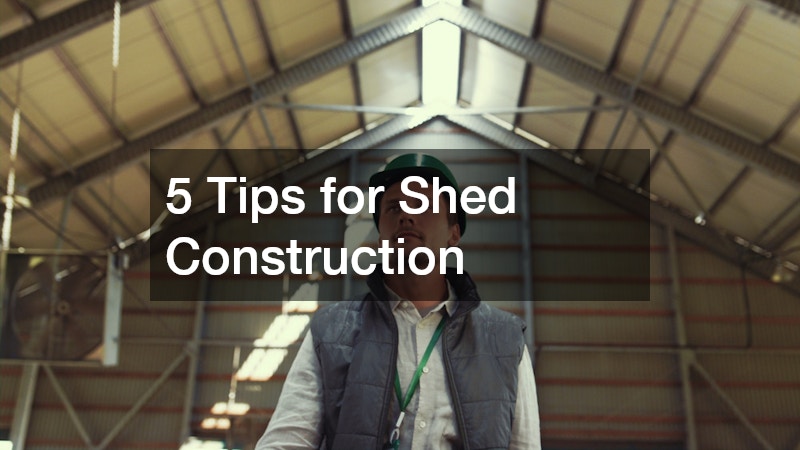Building a shed can transform your backyard into a more functional and organized space. Whether you need extra storage for tools and equipment or a dedicated workspace, a well-constructed shed is an invaluable addition to any property. In this article, we’ll explore essential tips for effective shed construction, ensuring your project is successful and meets all your needs.
1. Planning
Before starting your construction project, comprehensive planning is crucial. Begin by determining the primary purpose of your shed, as this will influence the size, design, and location in your yard.
Once you have a clear idea of its function, sketch a basic blueprint to visualize the layout and features. Shed construction success often hinges on thoughtful planning.
Take note of any zoning laws or building codes in your area that may affect your shed construction. Permits are often a requirement for larger structures, and failing to comply may lead to fines or mandated teardown. Additionally, decide on whether you will require utilities like electricity or plumbing in your shed, which will influence the construction process and overall cost.
Consider the materials you wish to use for your shed construction. The choice between wood, metal, or vinyl depends on factors like budget, climate, and aesthetic preferences. Each material has its advantages and disadvantages in terms of durability, insulation, and maintenance, so choose what aligns best with your needs and local weather conditions.
2. Building a Solid Foundation
A solid foundation is vital for shed construction as it ensures stability and longevity. Begin by selecting a level site that provides natural drainage, preventing water accumulation under your structure. Preparing the ground by clearing it of debris and vegetation will offer a clean slate for foundation work.
There are multiple foundation types to consider during construction, such as gravel, concrete blocks, or a poured concrete slab. A gravel foundation is cost-effective and offers excellent drainage, suitable for smaller sheds. Conversely, a concrete slab provides superior durability and is recommended for larger structures or those housing heavy equipment.
Proper foundation installation will protect your shed from moisture issues and structural damage. Consult with construction experts or construction guides to determine the best foundation choice for your specific project. Always prioritize precision in this initial step, as a stable foundation will support the entire structure.
3. Selecting Durable and Efficient Materials
When it comes to building a shed, choosing durable materials will reduce long-term maintenance and repair needs. Opt for high-quality, weather-resistant options to ensure your shed can withstand varying climate conditions. Cedarwood is a popular choice for its natural resistance to rot and insects, making it ideal for outdoor structures.
Efficient materials will also impact your shed’s energy usage, especially if utilities are included. Insulating walls and ceilings can maintain a consistent internal temperature, reducing energy costs for heating or cooling. Consider adding windows to maximize natural light and improve ventilation within your shed.
4. Focusing on Practical Design Features
Incorporating practical design features in your shed construction will enhance functionality and convenience. Adding shelves, workbenches, and pegboards will help organize tools and materials efficiently. A thoughtful design can transform your shed into a highly productive space tailored to your hobbies or professional needs.
Be sure that your shed’s entrance is wide enough to accommodate the largest items you intend to store. Double doors or sliding barn doors are excellent choices for ease of access during shed construction. Ample ventilation through windows or roof vents is essential for regulating temperature and preventing mold growth inside.
Consider aesthetics and how the shed construction complements your property’s existing structures. Using the same color scheme or roofing materials as your house can create a cohesive appearance. Additionally, landscaping around the shed can soften the structure’s impact on your yard’s overall look.
5. Maintaining Your Shed for Longevity
Proper maintenance after shed construction will extend its lifespan and preserve its appearance. Regularly inspect the structure for signs of wear, such as rust, rot, or leaks, and address issues promptly to prevent escalation. Keeping your shed clean and free of debris will minimize damage and maintain functionality.
Repainting or sealing wooden components every few years helps protect against weather damage. For metal sheds, checking for rust and applying anti-corrosion treatments can prevent structural degradation. Vinyl sheds benefit from periodic washing to remove dirt buildup and maintain their appearance.
Ensure gutters and drainage systems remain clear to avoid water pooling around the foundation. This prevents moisture-related problems that could threaten the integrity of your shed construction. A well-maintained shed not only extends its use but also preserves the investment you’ve made.
Shed construction is a rewarding project that enhances the practicality and charm of your property. By planning carefully, selecting the right materials, and focusing on durability and design, you can create a shed that meets your needs and withstands the test of time. Remember to prioritize maintenance to protect your investment and enjoy your new space for many years.
.

